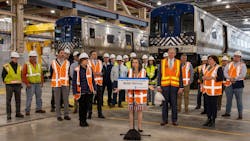Upgrades completed at MTA’s Metro-North Railroad’s maintenance and operations hub at Croton
Upgrades have been completed to Metropolitan Transportation Authority’s (MTA) Metro-North Railroad’s vital maintenance and operations hub at Croton-on-Hudson, N.Y., which employs 1,200 people. With the opening of this new 400,000 square foot facility, known as the Harmon Shop, MTA Metro-North will be able to maintain train reliability and meet the maintenance needs of its operations for decades to come.
“Today’s announcement builds on our commitment to ensuring our transit systems remain safe, effective and rider-friendly,” said New York Gov. Kathy Hochul. “These upgrades are investments for the railroad to operate reliably for the public, with trains arriving on time and with enough cars to carry all the passengers who want to ride.”
“Metro-North service has never been better – 99 percent on time performance so far this year. A big reason is the way our car fleet is being maintained and repaired here at the Harmon Shop – a world class facility second to none,” said MTA Chair and CEO Janno Lieber.
The project, which includes state and federal funding, modernizes the railroad’s heart of operations. MTA Metro-North notes that when it inherited the site from its predecessor railroads in 1983, it was immediately recognized as inadequate to meet the needs of crews, who would maintain the railroad’s fleets of rail cars and locomotives. The MTA identified capital funds to make upgrades in the late 1990s and work has been underway since 2001 to make the necessary upgrades.
The final phase of the project included the construction of a brand-new facility that includes repair and support shops. The state-of-the-art facility allows MTA Metro-North to perform its Reliability Centered Maintenance program and account for unscheduled repairs on their entire electric fleet. The facility has been equipped with a dozen car-hoists, four pedestal tracks and multiple door level and roof level platforms to assist in the preventive maintenance. The second floor is designed to streamline the parts distribution between the new electric shop and adjacent support shops and the consist maintenance shop by integrating a service corridor connecting all three buildings.
For more than 100 years, the Harmon Yard has played a vital role in the railroad’s daily operations. The project was completed during 23 years in five phases:
- Crews built service tracks, a new employee overpass and provided wayside power to the yard to significantly reduce the idling engines in the yard, reducing noise to the surrounding neighbors and producing less fossil fuel emissions.
- Crews built Communication & Maintenance of Way buildings and made modifications to the Material Distribution Center.
- Crews built a new Coach Shop and new Locomotive Shop, as well as a new Wheel True Facility with a Tandem Underfloor Wheel Lathe designed to maintain MTA Metro-North’s fleet of M-7 self-propelled electric railcars and future fleets.
- Provided for priority repairs on multi-purpose building to house shops, primarily on the western section of the building that will remain operational during construction, as well as the construction of a new Wheel Storage Canopy in the north yard.
- Provided the complete replacement of the multi-purpose building in two stages. The first stage provided for the construction of a new double-ended Consist Shop with two tracks each 10 cars long. The second stage included construction of the EMU Running Repair and Support shops.
“The Harmon Yard is the heart of Metro-North's operations and the timing of this project completion could not be better. Metro-North is currently in the middle of an impressive streak – four straight years with an on-time performance of at least 97 percent. Now, with a completed Harmon Yard, the railroad can continue to deliver exceptional service to the tens of thousands daily riders,” said MTA Metro-North Railroad President Catherine Rinaldi.
“This is sort of long-term investment is what it takes to bring a century-old system into the modern age. Thanks to this sustained capital investment, Metro-North riders will benefit for decades to come,” said MTA Construction & Development President Jamie Torres-Springer.
